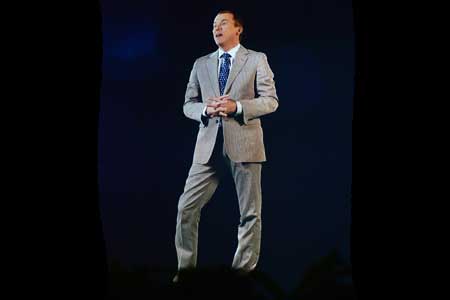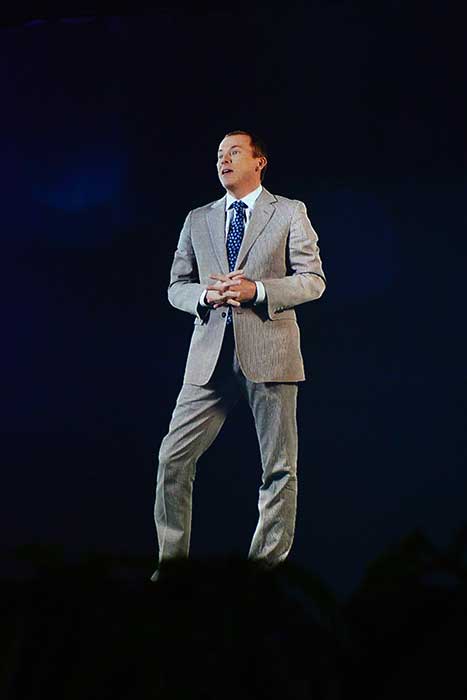Holograms Go To School


At the recent Cypress-Fairbanks Independent School Districtconference, Ron Clark, the animated founder of the Ron Clark Academy, presented the opening keynote. Clark shared a variety of inspiring stories from his time as a teacher with the audience of Texas-based educators with his usual enthusiasm. The twist? Clark’s presentation had been pre-recorded and was being projected as a hologram--or “HumaGram" as co-developers Promethean and ARHT Media call it. The audience reaction to the augmented Clark was no different than if he was actually in the room. They laughed and applauded—a few latecomers didn’t even realize he was a HumaGram and asked if he would be available at a book signing after the event.
This new technology is the latest to join the growing offerings in the world of Augmented and Virtual Reality. Where Virtual Reality is an immersive experience, immersing consumers into an entirely digital world, Augmented Reality is the ultimate in blended learning, combining real with digital elements to enhance the real-world environment. Promethean describes “HumaGrams” as ultra-enhanced holograms that “beam” a presenter to anywhere in the world and to multiple places at the same time--in real time or as a pre-recorded video. Real-time presenters are able to see, hear, and interact with their audiences. Where Skype or Google Hangouts lock a presenter’s grainy face onto a screen, the HumaGram presenters appear fully in the room in Star Trek-like fashion.
This technology has been used in the entertainment, healthcare, and retail industries, but the venture into education is new terrain. Applications for this tech abound in education, including:
-Professional development: Teachers no longer need to leave school for training. Trainers can present from a central location and “beam” their HumaGrams into schools across the district and beyond. They can interact with students throughout the training.
-Conferences: No more worrying about covering Sir Ken’s T&E – just beam in his HumaGram for a compelling interactive presentation.
-College and career prep: Schools can partner with high-tech engineers at NASA or Lockhead Martin and invite these experts to beam in to teach high school students the real-world work skills their companies are seeking. Because these experts won’t have to travel, they could go beyond one-day guest appearances, even offering complete interactive classes to multiple classroom simultaneously and in real time.
-Offer access to specialty teachers: Like the corporate experts, schools can share expert teachers via hologram without losing the interactive engagement of an on-site teacher.
Tools and ideas to transform education. Sign up below.
-Take virtual field trips further: Students can chat with a holograms of, say, archeologists leading excavations from all over the world.
In all of these examples—and these are just a few--presenters can pull up stats, Google maps, or videos that will appear to hover next to them as they speak thanks to the green screen technology used as part of the system (think local TV weather reports).Students cannot only interact with the hologram presenters, but with the other remote participating classrooms. Throw in some Google Docs and these classes can collaborate on all kinds of projects.
How It Works
According to Paul Duffy, CEO of ARHT Media, the technology works in three steps:
1.Capture: A room or studio is set up with a green screen and a 4K+ camera designed to capture an average space of about 12’x16’ to allow the recorded presenter enough room to move around.In a studio, the presenter will be able to see her audience on a panel in front of her that is captured by cameras on the receiving end. The 4K camera uses the AHRT engine to divide the image into 4 quadrants: (1) capturing the full body; (2) capturing a close-up of the presenter and (3) 2 other frames. The software combines these quadrants to ensure the most life-like capture.
2.Transmit: AHRT creates a dedicated path over the Internet for a clean transmission signal.
3.Display: The receiving audience uses a kit that includes: an AHRT screen onto which they project the image; the AHRT engine; and lighting (being careful to avoid direct light on the surface of the AHRT screen). Duffy noted a classroom could use a smaller screen and projector (though the capture space would need to be smaller).
“We envision the best experts and educators in the world beaming into schools on a monthly, weekly, or even daily basis,” Vincent Young, Chief Marketing Officer for Promethean.
While this tech is still in the visionary stage, and no education pricing has yet been announced, it will be interesting to see how it develops.
Christine Weiser is the Content and Brand Director for Tech & Learning, and has been with the company since 2008. She has reported on education for most of her career, working at Scholastic and Gale Publishing before joining Tech & Learning. Christine is also an author and musician, and lives in Philadelphia with her husband and son.
